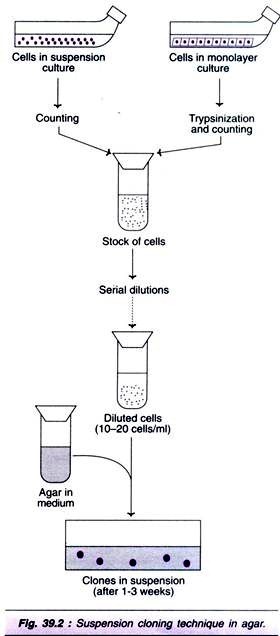The below mentioned article provides a general account of suspension culture.
Suspension culture can be initiated either from pre-established callus culture or from the explant directly into liquid medium which is continuously agitated on a moving elliptical or rotary shaker.
The movement of the nutrient medium provides vital aeration of the medium to sustain cell respiration in the liquid medium and also encourages the callus tissue to break up.
As cell division starts in the callus tissue or on the explant surface, they shed and disperse directly into the medium. More friable callus tissue is an ideal material for the dispersion of cells. The dispersion of less friable tissue may be improved by modifying the nutrient medium.
Increasing the concentration of auxins or adding very low concentration of cellulose and pectinase enzymes in the liquid medium are also effective for the dispersion of cells. The most dispersed culture so far established e.g. suspension culture of sycamore; consist of cell aggregates as well as single cells (Fig 4.2).
The period of incubation during which the suspension culture is developed from callus tissue is usually called as the initiation passage. During this passage not only do the callus tissues break up but the cells grow and divide until the depletion of some nutrient in the medium.
Suspension culture is established in conical flasks (150 ml, 250 ml) and is incubated on a shaker at the speed of 80-120 rpm. The cell suspension developed at the initial passage is passed through a nylon mesh to remove the larger pieces of callus tissue. The filtrate containing small cell aggregates and single cells is transferred into fresh liquid medium to initiate passage 1 suspension.
In the subsequent passages cell suspension is sub-cultured by pipetting off aliquots of the suspension into new flasks of culture medium. In general, the media suitable for growing callus cultures for a particular species are also suitable for growing suspension cultures providing that agar is omitted.
In some cases, the concentration of auxins and cytokinins is often critical for the growth of cell suspension and the concentration of auxins and cytokinins used for callus culture is generally reduced for suspension culture.
The cells within the aggregates are in a different microenvironment from the free floating cells. The cells in suspension may vary in shapes and sizes. They may be oval, round, elongated, coiled etc. Although suspension cultures consist entirely of thin-walled cells, others possess a proportion of lignified, tracheid like elements. These usually arise in the cell aggregates.
The cell aggregates within a suspension may give rise to whole plants by formation of root and shoot primordia e.g. suspension culture of Atropa belladonna. An alternative pathway of development of cell aggregates can lead to the formation of embryo-like structures or embryoids. e.g., suspension culture of carrot.
During embryoid formation, a single cell divides and follows two-celled stage, five-celled stage multicultural globular stage, heart-shaped stage etc. Each embryoid is a bipolar structure and results from divisions of a single cell. Emryoids, when mature, can be grown into a plantlet.
It may be more convenient to transfer cell aggregates from liquid medium and plate them on to solidified medium to grow as a callus. It is possible to plate out single cells from a suspension culture and raise a callus from them. By this way, a whole plant could be regenerated from a single cell.

